PRSK4048 Professional Skills Portfolio: Teamwork and Ethics
VerifiedAdded on 2020/10/22
|15
|5551
|397
Project
AI Summary
This document presents a student's Professional Skills Portfolio (PRSK4048) assignment, encompassing teamwork, professional ethics, and project management. The assignment includes a Belbin questionnaire to identify team roles, a discussion on applying Belbin theory in team selection, and strategies to encourage creativity and individualism. The student analyzes their primary (coordinator) and secondary (monitor evaluator) team roles based on the Belbin assessment and past experiences, and provides a self-perception inventory. Furthermore, the portfolio covers ethical considerations, including a code of conduct and an in-class writing task. It also incorporates project management elements like a Gantt chart and evidence of a group presentation, demonstrating practical application of professional skills. The total word count is 2,100 words.
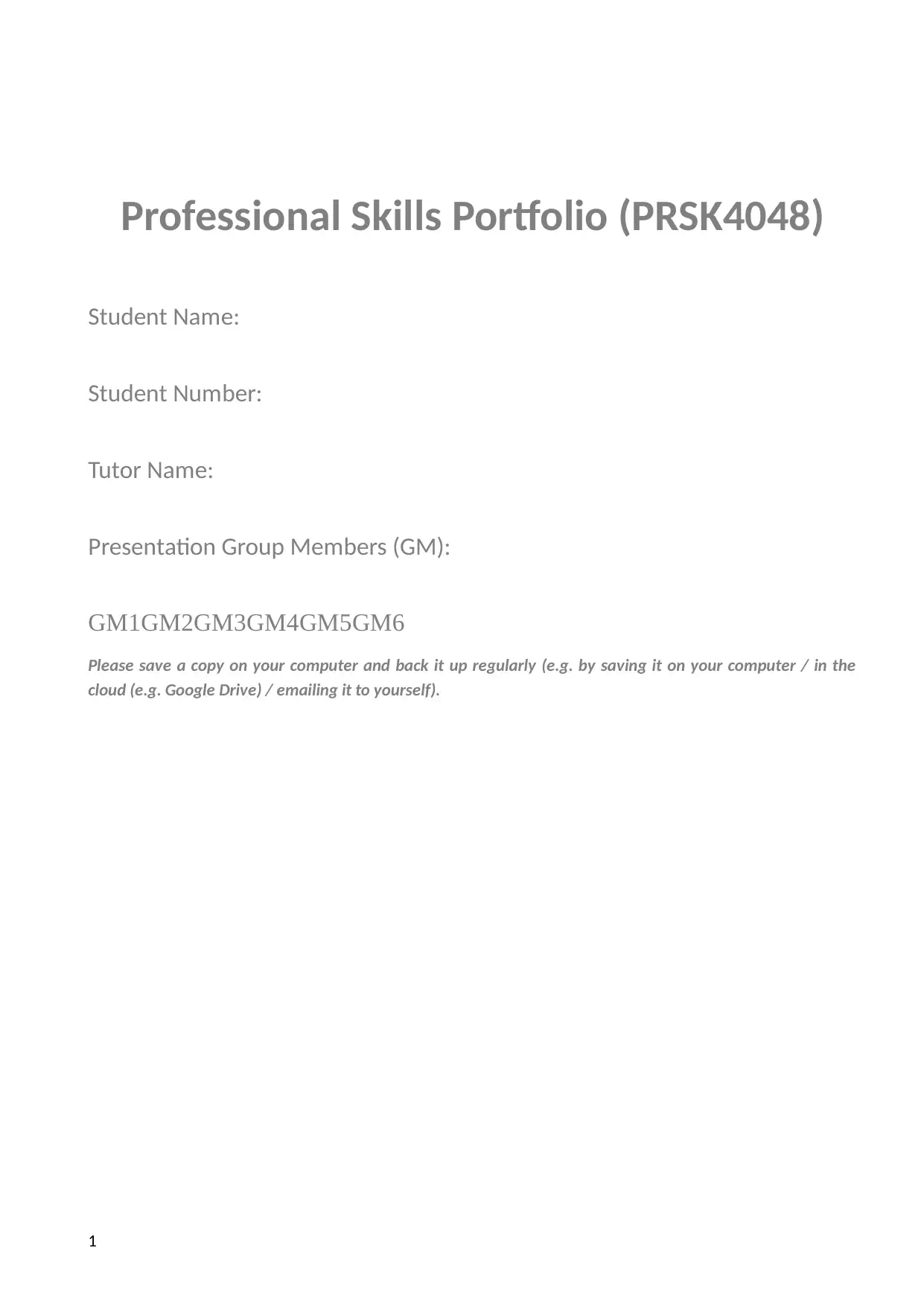
Professional Skills Portfolio (PRSK4048)
Student Name:
Student Number:
Tutor Name:
Presentation Group Members (GM):
GM1GM2GM3GM4GM5GM6
Please save a copy on your computer and back it up regularly (e.g. by saving it on your computer / in the
cloud (e.g. Google Drive) / emailing it to yourself).
1
Student Name:
Student Number:
Tutor Name:
Presentation Group Members (GM):
GM1GM2GM3GM4GM5GM6
Please save a copy on your computer and back it up regularly (e.g. by saving it on your computer / in the
cloud (e.g. Google Drive) / emailing it to yourself).
1
Paraphrase This Document
Need a fresh take? Get an instant paraphrase of this document with our AI Paraphraser
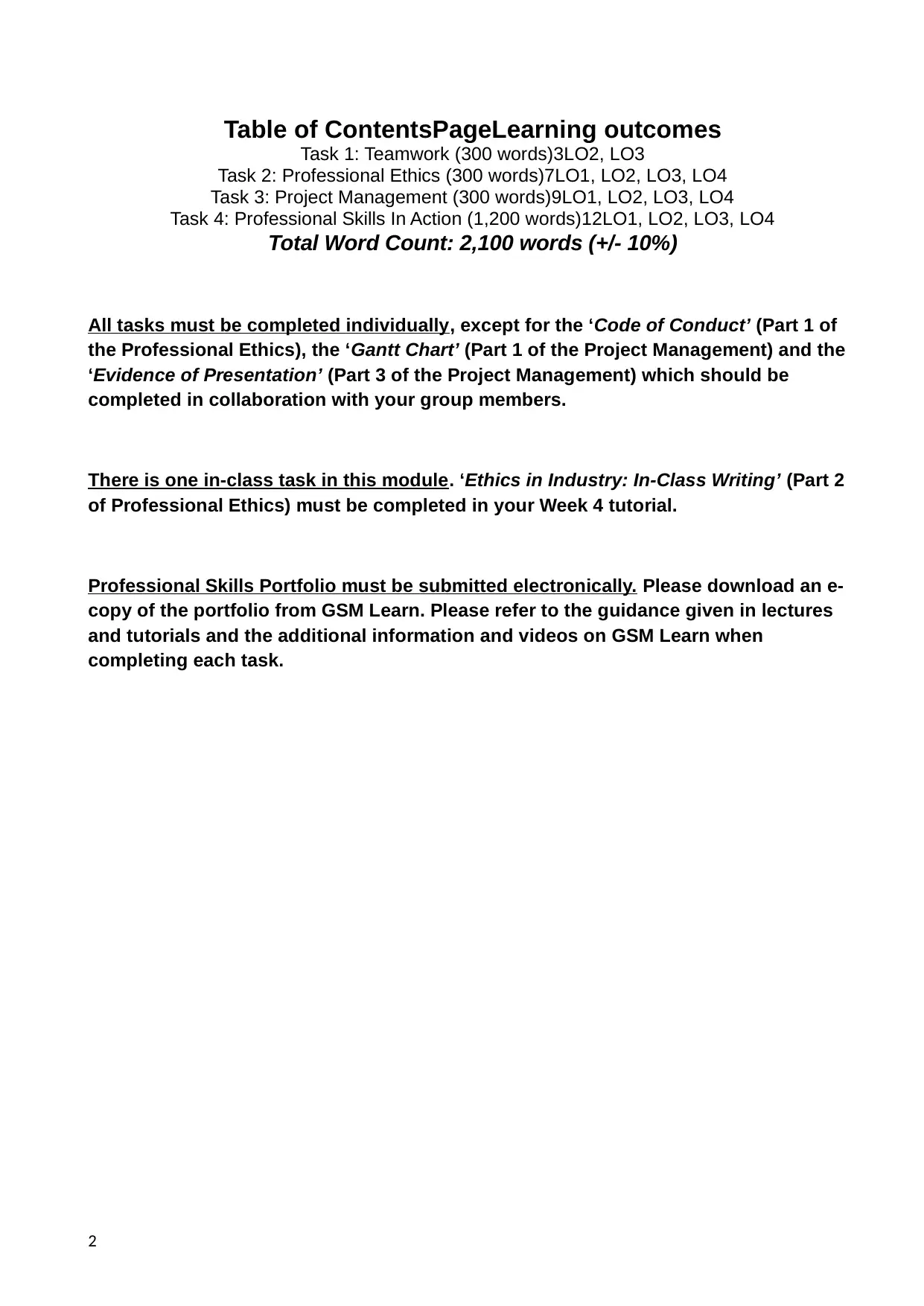
Table of ContentsPageLearning outcomes
Task 1: Teamwork (300 words)3LO2, LO3
Task 2: Professional Ethics (300 words)7LO1, LO2, LO3, LO4
Task 3: Project Management (300 words)9LO1, LO2, LO3, LO4
Task 4: Professional Skills In Action (1,200 words)12LO1, LO2, LO3, LO4
Total Word Count: 2,100 words (+/- 10%)
All tasks must be completed individually, except for the ‘Code of Conduct’ (Part 1 of
the Professional Ethics), the ‘Gantt Chart’ (Part 1 of the Project Management) and the
‘Evidence of Presentation’ (Part 3 of the Project Management) which should be
completed in collaboration with your group members.
There is one in-class task in this module. ‘Ethics in Industry: In-Class Writing’ (Part 2
of Professional Ethics) must be completed in your Week 4 tutorial.
Professional Skills Portfolio must be submitted electronically. Please download an e-
copy of the portfolio from GSM Learn. Please refer to the guidance given in lectures
and tutorials and the additional information and videos on GSM Learn when
completing each task.
2
Task 1: Teamwork (300 words)3LO2, LO3
Task 2: Professional Ethics (300 words)7LO1, LO2, LO3, LO4
Task 3: Project Management (300 words)9LO1, LO2, LO3, LO4
Task 4: Professional Skills In Action (1,200 words)12LO1, LO2, LO3, LO4
Total Word Count: 2,100 words (+/- 10%)
All tasks must be completed individually, except for the ‘Code of Conduct’ (Part 1 of
the Professional Ethics), the ‘Gantt Chart’ (Part 1 of the Project Management) and the
‘Evidence of Presentation’ (Part 3 of the Project Management) which should be
completed in collaboration with your group members.
There is one in-class task in this module. ‘Ethics in Industry: In-Class Writing’ (Part 2
of Professional Ethics) must be completed in your Week 4 tutorial.
Professional Skills Portfolio must be submitted electronically. Please download an e-
copy of the portfolio from GSM Learn. Please refer to the guidance given in lectures
and tutorials and the additional information and videos on GSM Learn when
completing each task.
2

Task 1: Teamwork [weeks 1 and 2]
This task consists of three parts:
1Belbin Questionnaire
2Scoring Key for Self-Perception Inventory
3Written Discussion (300 words)
Part 1: Belbin Questionnaire
Belbin (1996) outlines the different type of roles people may have within a team. Complete the
following questionnaire to identify your main role(s). To complete the questionnaire:
1. In the far left hand columns in each section A-G tick the one, two or max. three sentences most
applicable to yourself. You may not choose more sentences than three.
2. Then in each section A-G in the column on the right, share 10 points between those sentences (i.e.
QN - question numbers) that apply to you. For example, you could give your first choice seven points
and three points to your second choice if one of sentences you feel sums you up well while the other
only applies some of the time. In some instances you might decide that there are two sentences which
apply to you equally – if this is the case, award five points to each. You may distribute 10 points in any
way you see fit.
SECTION A
1TickQNWhen involved in a project with other people:Points?I can be relied upon to see that work
that needs to be done is organised.4I pick up slips and omissions that others fail to notice.I react
strongly when meetings look like losing track of the main objective.I produce original suggestions.?I
analyse other people’s ideas objectively, for both merits and failings.2?I am keen to find out the latest
ideas and developments.4I have an aptitude for organising people.I am always ready to support good
suggestions that help to resolve a problem.
SECTION B
1TickQNIn seeking satisfaction through my work:Points?I like to have a strong influence on
decisions.5I feel in my element where work requires a high degree of attention and concentration.I am
concerned to help colleagues with their problems.?I like to make critical discrimination between
alternatives.2I tend to have a creative approach to problem solving.?I enjoy reconciling different points
of view.3I am more interested in practicalities than new ideas.I particularly enjoy exploring different
views and techniques.
SECTION C
1TickQNWhen the team is trying to solve a particularly complex problem:PointsI keep a watching
eye on areas where difficulty may arise.?I explore ideas that may have a wider application than in the
immediate task.4?I like to weigh up and evaluate a range of suggestions thoroughly before choosing.6I
can co-ordinate and use productively other people’s abilities and talents.I maintain a steady
systematic approach, whatever the pressures.I often produce a new approach to a long continuing
problem.I am ready to make my personal views known in a forceful way if necessary.I am ready to
help whenever I can.
3
This task consists of three parts:
1Belbin Questionnaire
2Scoring Key for Self-Perception Inventory
3Written Discussion (300 words)
Part 1: Belbin Questionnaire
Belbin (1996) outlines the different type of roles people may have within a team. Complete the
following questionnaire to identify your main role(s). To complete the questionnaire:
1. In the far left hand columns in each section A-G tick the one, two or max. three sentences most
applicable to yourself. You may not choose more sentences than three.
2. Then in each section A-G in the column on the right, share 10 points between those sentences (i.e.
QN - question numbers) that apply to you. For example, you could give your first choice seven points
and three points to your second choice if one of sentences you feel sums you up well while the other
only applies some of the time. In some instances you might decide that there are two sentences which
apply to you equally – if this is the case, award five points to each. You may distribute 10 points in any
way you see fit.
SECTION A
1TickQNWhen involved in a project with other people:Points?I can be relied upon to see that work
that needs to be done is organised.4I pick up slips and omissions that others fail to notice.I react
strongly when meetings look like losing track of the main objective.I produce original suggestions.?I
analyse other people’s ideas objectively, for both merits and failings.2?I am keen to find out the latest
ideas and developments.4I have an aptitude for organising people.I am always ready to support good
suggestions that help to resolve a problem.
SECTION B
1TickQNIn seeking satisfaction through my work:Points?I like to have a strong influence on
decisions.5I feel in my element where work requires a high degree of attention and concentration.I am
concerned to help colleagues with their problems.?I like to make critical discrimination between
alternatives.2I tend to have a creative approach to problem solving.?I enjoy reconciling different points
of view.3I am more interested in practicalities than new ideas.I particularly enjoy exploring different
views and techniques.
SECTION C
1TickQNWhen the team is trying to solve a particularly complex problem:PointsI keep a watching
eye on areas where difficulty may arise.?I explore ideas that may have a wider application than in the
immediate task.4?I like to weigh up and evaluate a range of suggestions thoroughly before choosing.6I
can co-ordinate and use productively other people’s abilities and talents.I maintain a steady
systematic approach, whatever the pressures.I often produce a new approach to a long continuing
problem.I am ready to make my personal views known in a forceful way if necessary.I am ready to
help whenever I can.
3
⊘ This is a preview!⊘
Do you want full access?
Subscribe today to unlock all pages.

Trusted by 1+ million students worldwide
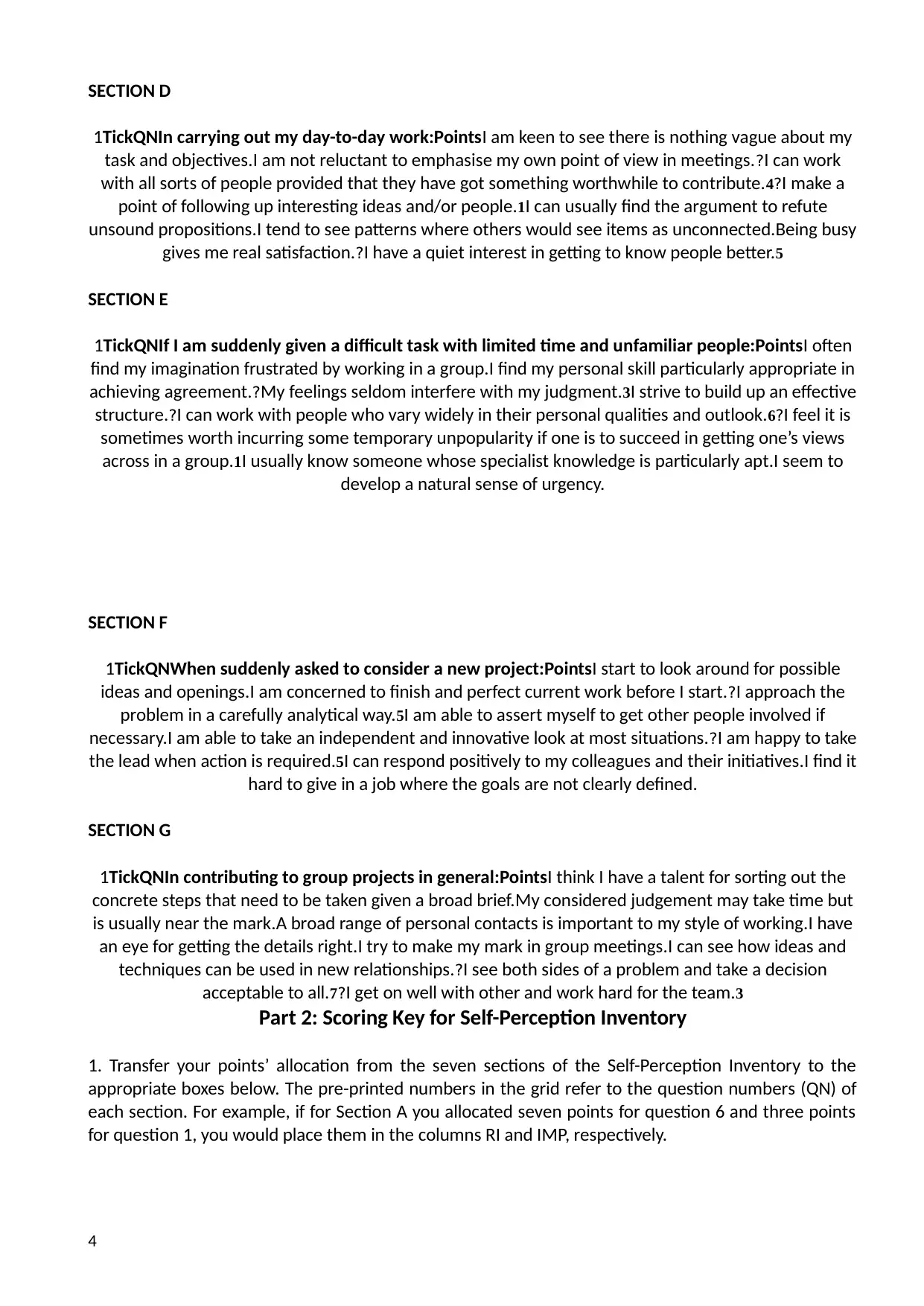
SECTION D
1TickQNIn carrying out my day-to-day work:PointsI am keen to see there is nothing vague about my
task and objectives.I am not reluctant to emphasise my own point of view in meetings.?I can work
with all sorts of people provided that they have got something worthwhile to contribute.4?I make a
point of following up interesting ideas and/or people.1I can usually find the argument to refute
unsound propositions.I tend to see patterns where others would see items as unconnected.Being busy
gives me real satisfaction.?I have a quiet interest in getting to know people better.5
SECTION E
1TickQNIf I am suddenly given a difficult task with limited time and unfamiliar people:PointsI often
find my imagination frustrated by working in a group.I find my personal skill particularly appropriate in
achieving agreement.?My feelings seldom interfere with my judgment.3I strive to build up an effective
structure.?I can work with people who vary widely in their personal qualities and outlook.6?I feel it is
sometimes worth incurring some temporary unpopularity if one is to succeed in getting one’s views
across in a group.1I usually know someone whose specialist knowledge is particularly apt.I seem to
develop a natural sense of urgency.
SECTION F
1TickQNWhen suddenly asked to consider a new project:PointsI start to look around for possible
ideas and openings.I am concerned to finish and perfect current work before I start.?I approach the
problem in a carefully analytical way.5I am able to assert myself to get other people involved if
necessary.I am able to take an independent and innovative look at most situations.?I am happy to take
the lead when action is required.5I can respond positively to my colleagues and their initiatives.I find it
hard to give in a job where the goals are not clearly defined.
SECTION G
1TickQNIn contributing to group projects in general:PointsI think I have a talent for sorting out the
concrete steps that need to be taken given a broad brief.My considered judgement may take time but
is usually near the mark.A broad range of personal contacts is important to my style of working.I have
an eye for getting the details right.I try to make my mark in group meetings.I can see how ideas and
techniques can be used in new relationships.?I see both sides of a problem and take a decision
acceptable to all.7?I get on well with other and work hard for the team.3
Part 2: Scoring Key for Self-Perception Inventory
1. Transfer your points’ allocation from the seven sections of the Self-Perception Inventory to the
appropriate boxes below. The pre-printed numbers in the grid refer to the question numbers (QN) of
each section. For example, if for Section A you allocated seven points for question 6 and three points
for question 1, you would place them in the columns RI and IMP, respectively.
4
1TickQNIn carrying out my day-to-day work:PointsI am keen to see there is nothing vague about my
task and objectives.I am not reluctant to emphasise my own point of view in meetings.?I can work
with all sorts of people provided that they have got something worthwhile to contribute.4?I make a
point of following up interesting ideas and/or people.1I can usually find the argument to refute
unsound propositions.I tend to see patterns where others would see items as unconnected.Being busy
gives me real satisfaction.?I have a quiet interest in getting to know people better.5
SECTION E
1TickQNIf I am suddenly given a difficult task with limited time and unfamiliar people:PointsI often
find my imagination frustrated by working in a group.I find my personal skill particularly appropriate in
achieving agreement.?My feelings seldom interfere with my judgment.3I strive to build up an effective
structure.?I can work with people who vary widely in their personal qualities and outlook.6?I feel it is
sometimes worth incurring some temporary unpopularity if one is to succeed in getting one’s views
across in a group.1I usually know someone whose specialist knowledge is particularly apt.I seem to
develop a natural sense of urgency.
SECTION F
1TickQNWhen suddenly asked to consider a new project:PointsI start to look around for possible
ideas and openings.I am concerned to finish and perfect current work before I start.?I approach the
problem in a carefully analytical way.5I am able to assert myself to get other people involved if
necessary.I am able to take an independent and innovative look at most situations.?I am happy to take
the lead when action is required.5I can respond positively to my colleagues and their initiatives.I find it
hard to give in a job where the goals are not clearly defined.
SECTION G
1TickQNIn contributing to group projects in general:PointsI think I have a talent for sorting out the
concrete steps that need to be taken given a broad brief.My considered judgement may take time but
is usually near the mark.A broad range of personal contacts is important to my style of working.I have
an eye for getting the details right.I try to make my mark in group meetings.I can see how ideas and
techniques can be used in new relationships.?I see both sides of a problem and take a decision
acceptable to all.7?I get on well with other and work hard for the team.3
Part 2: Scoring Key for Self-Perception Inventory
1. Transfer your points’ allocation from the seven sections of the Self-Perception Inventory to the
appropriate boxes below. The pre-printed numbers in the grid refer to the question numbers (QN) of
each section. For example, if for Section A you allocated seven points for question 6 and three points
for question 1, you would place them in the columns RI and IMP, respectively.
4
Paraphrase This Document
Need a fresh take? Get an instant paraphrase of this document with our AI Paraphraser

SHCOPLRIMEIMPTWCFQNPointsQNPointsQNPointsQNPointsQNPointsQNPointsQNPointsQNA3.7.4.6.45.21.48.2
.B1.56.35.8.4.27.3.2.C7.4.6.2.43.65.8.1.D2.3.46.4.15.1.8.57.E6.15.61.7.3.34.2.8.F6.54.5.1.3.58.7.2.G5.7.
76.3.2.1.8.34.Total1120091848
2. Once you have allocated all your points, total each column. The highest two totals represent your
primary and secondary preferred team roles. Highlight them.
5
.B1.56.35.8.4.27.3.2.C7.4.6.2.43.65.8.1.D2.3.46.4.15.1.8.57.E6.15.61.7.3.34.2.8.F6.54.5.1.3.58.7.2.G5.7.
76.3.2.1.8.34.Total1120091848
2. Once you have allocated all your points, total each column. The highest two totals represent your
primary and secondary preferred team roles. Highlight them.
5

Part 3: Written Discussion
In Week 2 tutorial your task will be to choose group members for the group project, i.e. group
presentation. In this evaluation:
·Discuss the application of Belbin theory in the selection of your team members, taking into
account various strengths and roles that could be assigned;
·Explain how creativity and individualism will be encouraged in your team;
·Comment on your individual primary and secondary team roles – to what extent do you agree
with the above scores; use evidence of past experiences (such as the tower building task) to
support your position.
Write 300 words.
Belbin's theory is an effective tool to select the team members on the basis of their roles. According to
this theory the team members can be selected for 3 different categories. At first shaper, completer and
implementer relates to the action. Secondly people oriented role consist of team-worker, coordinator
and resource investigator while the cerebral team member includes monitor evaluator, specialist and
plant. The action team members must be able to overcome challenges, efficient and anxious so that
they can accomplish tasks on time. The coordinator and other people oriented team members must be
good in decision making, clarification of goal, cooperative and good in communication skills
(Senaratne and Gunawardane, 2015). The members chosen for the cerebral roles must be innovative,
strategic and self starting so that knowledge can be properly applied to operations.
The individuality and creativity can be enhanced in teams by allowing every member to share their
opinion and innovative ideas. Every member must be treated with dignity and must be give equal
chance to take part in decision-making. It will assure that individualism is maintained in teams and
derisions are not taken by only few individuals. The conflict resolution approach is also an important
way to ensure that every team members can visualise himself or herself as part of team (Mathieu and
et.al., 2015).
My primary role as per the above analysis is of coordinator while my secondary role is of monitor
evaluator. I am satisfied with the scores of my primary and secondary team roles. Though in some
extent I think as monitor evaluator I lack certain skills. For instance monitor evaluator must be good in
strategic planning while I think that I need improvement in these skills. During the tower building task
as well my coordinator skills such as confidence, maturity and good decision making abilities were
demonstrated.
Reference List:
Mathieu, J.E., and et.al., 2015. Team role experience and orientation: A measure and tests of
construct validity. Group & Organization Management. 40(1). pp.6-34.
Senaratne, S. and Gunawardane, S., 2015. Application of team role theory to construction design
teams. Architectural Engineering and Design Management. 11(1). pp.1-20.
6
In Week 2 tutorial your task will be to choose group members for the group project, i.e. group
presentation. In this evaluation:
·Discuss the application of Belbin theory in the selection of your team members, taking into
account various strengths and roles that could be assigned;
·Explain how creativity and individualism will be encouraged in your team;
·Comment on your individual primary and secondary team roles – to what extent do you agree
with the above scores; use evidence of past experiences (such as the tower building task) to
support your position.
Write 300 words.
Belbin's theory is an effective tool to select the team members on the basis of their roles. According to
this theory the team members can be selected for 3 different categories. At first shaper, completer and
implementer relates to the action. Secondly people oriented role consist of team-worker, coordinator
and resource investigator while the cerebral team member includes monitor evaluator, specialist and
plant. The action team members must be able to overcome challenges, efficient and anxious so that
they can accomplish tasks on time. The coordinator and other people oriented team members must be
good in decision making, clarification of goal, cooperative and good in communication skills
(Senaratne and Gunawardane, 2015). The members chosen for the cerebral roles must be innovative,
strategic and self starting so that knowledge can be properly applied to operations.
The individuality and creativity can be enhanced in teams by allowing every member to share their
opinion and innovative ideas. Every member must be treated with dignity and must be give equal
chance to take part in decision-making. It will assure that individualism is maintained in teams and
derisions are not taken by only few individuals. The conflict resolution approach is also an important
way to ensure that every team members can visualise himself or herself as part of team (Mathieu and
et.al., 2015).
My primary role as per the above analysis is of coordinator while my secondary role is of monitor
evaluator. I am satisfied with the scores of my primary and secondary team roles. Though in some
extent I think as monitor evaluator I lack certain skills. For instance monitor evaluator must be good in
strategic planning while I think that I need improvement in these skills. During the tower building task
as well my coordinator skills such as confidence, maturity and good decision making abilities were
demonstrated.
Reference List:
Mathieu, J.E., and et.al., 2015. Team role experience and orientation: A measure and tests of
construct validity. Group & Organization Management. 40(1). pp.6-34.
Senaratne, S. and Gunawardane, S., 2015. Application of team role theory to construction design
teams. Architectural Engineering and Design Management. 11(1). pp.1-20.
6
⊘ This is a preview!⊘
Do you want full access?
Subscribe today to unlock all pages.

Trusted by 1+ million students worldwide
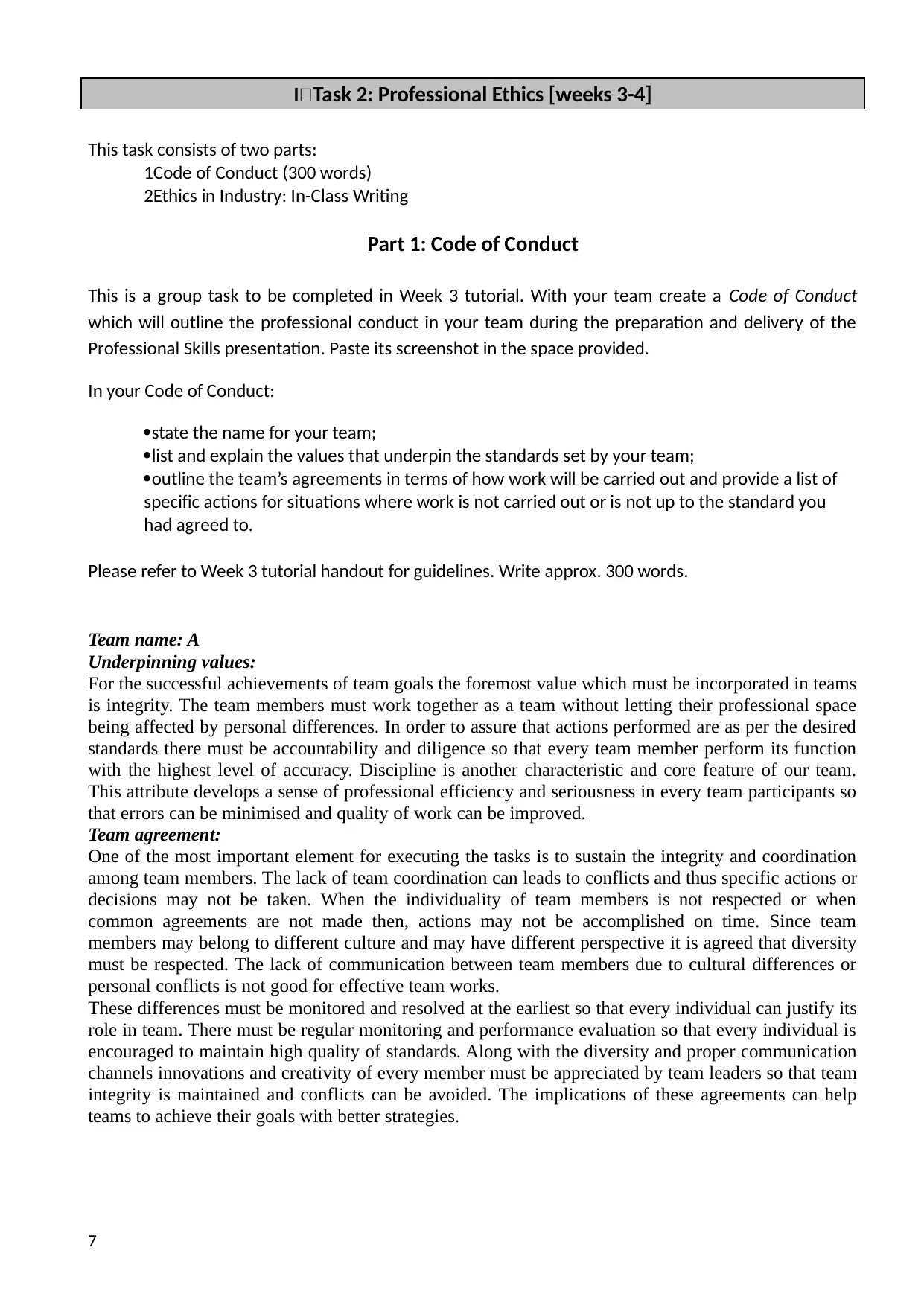
l壱Task 2: Professional Ethics [weeks 3-4]
This task consists of two parts:
1Code of Conduct (300 words)
2Ethics in Industry: In-Class Writing
Part 1: Code of Conduct
This is a group task to be completed in Week 3 tutorial. With your team create a Code of Conduct
which will outline the professional conduct in your team during the preparation and delivery of the
Professional Skills presentation. Paste its screenshot in the space provided.
In your Code of Conduct:
·state the name for your team;
·list and explain the values that underpin the standards set by your team;
·outline the team’s agreements in terms of how work will be carried out and provide a list of
specific actions for situations where work is not carried out or is not up to the standard you
had agreed to.
Please refer to Week 3 tutorial handout for guidelines. Write approx. 300 words.
Team name: A
Underpinning values:
For the successful achievements of team goals the foremost value which must be incorporated in teams
is integrity. The team members must work together as a team without letting their professional space
being affected by personal differences. In order to assure that actions performed are as per the desired
standards there must be accountability and diligence so that every team member perform its function
with the highest level of accuracy. Discipline is another characteristic and core feature of our team.
This attribute develops a sense of professional efficiency and seriousness in every team participants so
that errors can be minimised and quality of work can be improved.
Team agreement:
One of the most important element for executing the tasks is to sustain the integrity and coordination
among team members. The lack of team coordination can leads to conflicts and thus specific actions or
decisions may not be taken. When the individuality of team members is not respected or when
common agreements are not made then, actions may not be accomplished on time. Since team
members may belong to different culture and may have different perspective it is agreed that diversity
must be respected. The lack of communication between team members due to cultural differences or
personal conflicts is not good for effective team works.
These differences must be monitored and resolved at the earliest so that every individual can justify its
role in team. There must be regular monitoring and performance evaluation so that every individual is
encouraged to maintain high quality of standards. Along with the diversity and proper communication
channels innovations and creativity of every member must be appreciated by team leaders so that team
integrity is maintained and conflicts can be avoided. The implications of these agreements can help
teams to achieve their goals with better strategies.
7
This task consists of two parts:
1Code of Conduct (300 words)
2Ethics in Industry: In-Class Writing
Part 1: Code of Conduct
This is a group task to be completed in Week 3 tutorial. With your team create a Code of Conduct
which will outline the professional conduct in your team during the preparation and delivery of the
Professional Skills presentation. Paste its screenshot in the space provided.
In your Code of Conduct:
·state the name for your team;
·list and explain the values that underpin the standards set by your team;
·outline the team’s agreements in terms of how work will be carried out and provide a list of
specific actions for situations where work is not carried out or is not up to the standard you
had agreed to.
Please refer to Week 3 tutorial handout for guidelines. Write approx. 300 words.
Team name: A
Underpinning values:
For the successful achievements of team goals the foremost value which must be incorporated in teams
is integrity. The team members must work together as a team without letting their professional space
being affected by personal differences. In order to assure that actions performed are as per the desired
standards there must be accountability and diligence so that every team member perform its function
with the highest level of accuracy. Discipline is another characteristic and core feature of our team.
This attribute develops a sense of professional efficiency and seriousness in every team participants so
that errors can be minimised and quality of work can be improved.
Team agreement:
One of the most important element for executing the tasks is to sustain the integrity and coordination
among team members. The lack of team coordination can leads to conflicts and thus specific actions or
decisions may not be taken. When the individuality of team members is not respected or when
common agreements are not made then, actions may not be accomplished on time. Since team
members may belong to different culture and may have different perspective it is agreed that diversity
must be respected. The lack of communication between team members due to cultural differences or
personal conflicts is not good for effective team works.
These differences must be monitored and resolved at the earliest so that every individual can justify its
role in team. There must be regular monitoring and performance evaluation so that every individual is
encouraged to maintain high quality of standards. Along with the diversity and proper communication
channels innovations and creativity of every member must be appreciated by team leaders so that team
integrity is maintained and conflicts can be avoided. The implications of these agreements can help
teams to achieve their goals with better strategies.
7
Paraphrase This Document
Need a fresh take? Get an instant paraphrase of this document with our AI Paraphraser
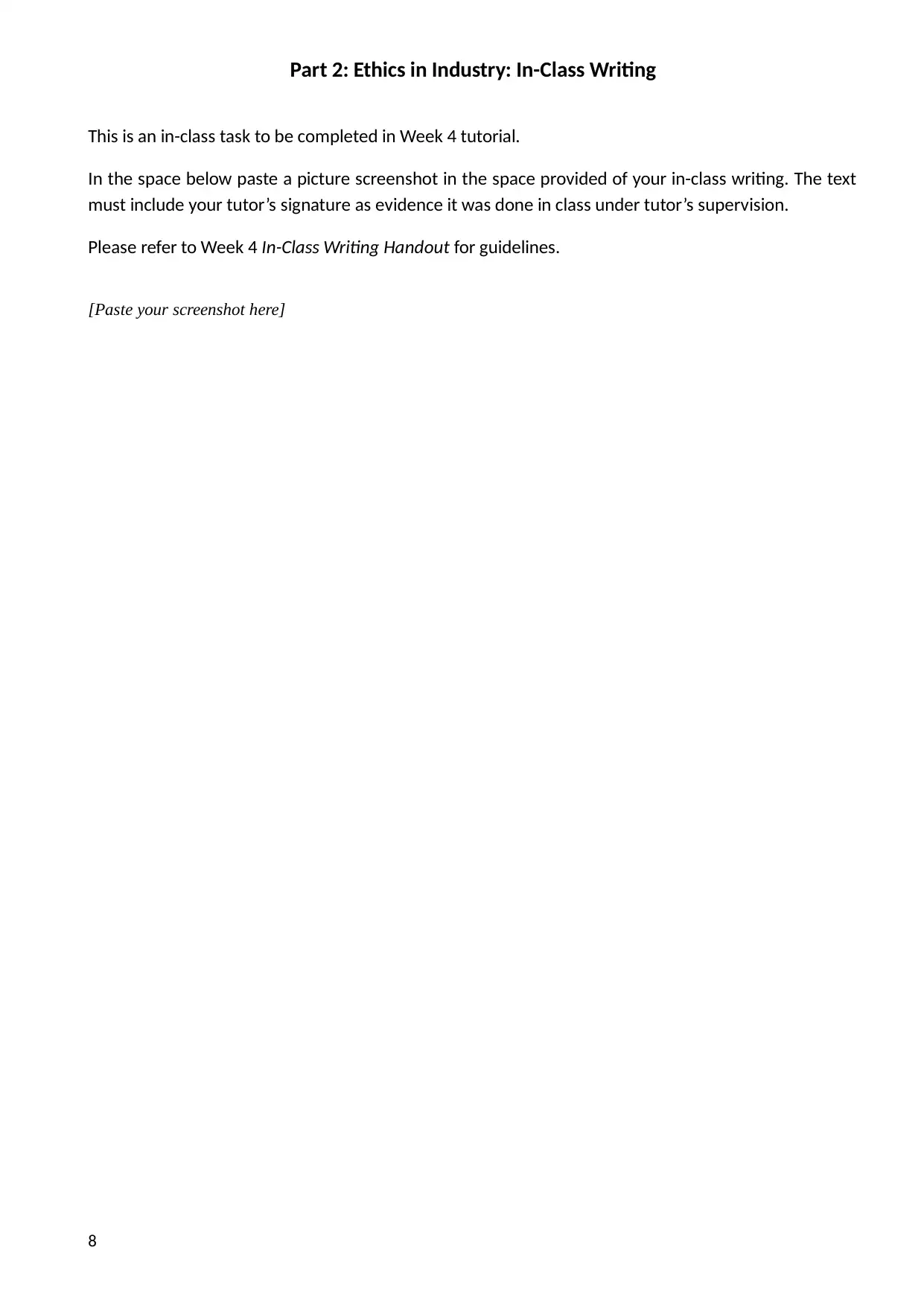
Part 2: Ethics in Industry: In-Class Writing
This is an in-class task to be completed in Week 4 tutorial.
In the space below paste a picture screenshot in the space provided of your in-class writing. The text
must include your tutor’s signature as evidence it was done in class under tutor’s supervision.
Please refer to Week 4 In-Class Writing Handout for guidelines.
[Paste your screenshot here]
8
This is an in-class task to be completed in Week 4 tutorial.
In the space below paste a picture screenshot in the space provided of your in-class writing. The text
must include your tutor’s signature as evidence it was done in class under tutor’s supervision.
Please refer to Week 4 In-Class Writing Handout for guidelines.
[Paste your screenshot here]
8

l壱Task 3: Project Management [weeks 5-8]
This task consists of three parts:
1Gantt Chart
2Discussion (300 words)
3Evidence of Presentation
Part 1: Gantt Chart
This is a group task. With your team use an Excel spreadsheet to create a Gantt chart for the preparation and delivery of the Professional Skills
presentation/video in week 9. Paste its screenshot in the space provided.
In your Gantt chart:
·name at least 5 key stages, i.e. summary tasks, for the work done during the Professional Skills module;
·identify the tasks for each group member, i.e. terminal tasks, and decide on start and end date for each of them;
·present the information on the timeline graphically.
Please refer to Week 5 tutorial handout for guidelines.
[Paste your screenshot here]
9
This task consists of three parts:
1Gantt Chart
2Discussion (300 words)
3Evidence of Presentation
Part 1: Gantt Chart
This is a group task. With your team use an Excel spreadsheet to create a Gantt chart for the preparation and delivery of the Professional Skills
presentation/video in week 9. Paste its screenshot in the space provided.
In your Gantt chart:
·name at least 5 key stages, i.e. summary tasks, for the work done during the Professional Skills module;
·identify the tasks for each group member, i.e. terminal tasks, and decide on start and end date for each of them;
·present the information on the timeline graphically.
Please refer to Week 5 tutorial handout for guidelines.
[Paste your screenshot here]
9
⊘ This is a preview!⊘
Do you want full access?
Subscribe today to unlock all pages.

Trusted by 1+ million students worldwide
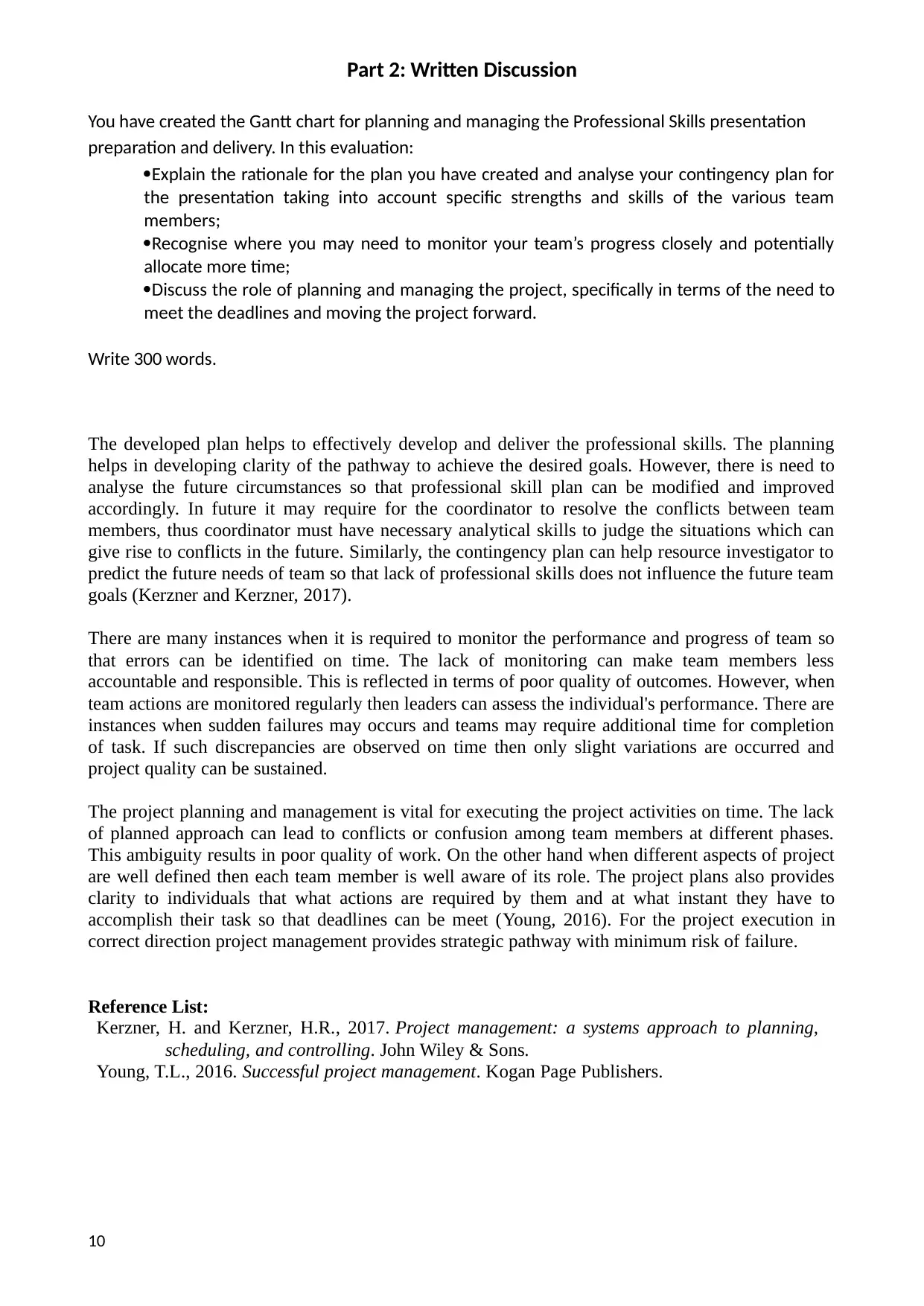
Part 2: Written Discussion
You have created the Gantt chart for planning and managing the Professional Skills presentation
preparation and delivery. In this evaluation:
·Explain the rationale for the plan you have created and analyse your contingency plan for
the presentation taking into account specific strengths and skills of the various team
members;
·Recognise where you may need to monitor your team’s progress closely and potentially
allocate more time;
·Discuss the role of planning and managing the project, specifically in terms of the need to
meet the deadlines and moving the project forward.
Write 300 words.
The developed plan helps to effectively develop and deliver the professional skills. The planning
helps in developing clarity of the pathway to achieve the desired goals. However, there is need to
analyse the future circumstances so that professional skill plan can be modified and improved
accordingly. In future it may require for the coordinator to resolve the conflicts between team
members, thus coordinator must have necessary analytical skills to judge the situations which can
give rise to conflicts in the future. Similarly, the contingency plan can help resource investigator to
predict the future needs of team so that lack of professional skills does not influence the future team
goals (Kerzner and Kerzner, 2017).
There are many instances when it is required to monitor the performance and progress of team so
that errors can be identified on time. The lack of monitoring can make team members less
accountable and responsible. This is reflected in terms of poor quality of outcomes. However, when
team actions are monitored regularly then leaders can assess the individual's performance. There are
instances when sudden failures may occurs and teams may require additional time for completion
of task. If such discrepancies are observed on time then only slight variations are occurred and
project quality can be sustained.
The project planning and management is vital for executing the project activities on time. The lack
of planned approach can lead to conflicts or confusion among team members at different phases.
This ambiguity results in poor quality of work. On the other hand when different aspects of project
are well defined then each team member is well aware of its role. The project plans also provides
clarity to individuals that what actions are required by them and at what instant they have to
accomplish their task so that deadlines can be meet (Young, 2016). For the project execution in
correct direction project management provides strategic pathway with minimum risk of failure.
Reference List:
Kerzner, H. and Kerzner, H.R., 2017. Project management: a systems approach to planning,
scheduling, and controlling. John Wiley & Sons.
Young, T.L., 2016. Successful project management. Kogan Page Publishers.
10
You have created the Gantt chart for planning and managing the Professional Skills presentation
preparation and delivery. In this evaluation:
·Explain the rationale for the plan you have created and analyse your contingency plan for
the presentation taking into account specific strengths and skills of the various team
members;
·Recognise where you may need to monitor your team’s progress closely and potentially
allocate more time;
·Discuss the role of planning and managing the project, specifically in terms of the need to
meet the deadlines and moving the project forward.
Write 300 words.
The developed plan helps to effectively develop and deliver the professional skills. The planning
helps in developing clarity of the pathway to achieve the desired goals. However, there is need to
analyse the future circumstances so that professional skill plan can be modified and improved
accordingly. In future it may require for the coordinator to resolve the conflicts between team
members, thus coordinator must have necessary analytical skills to judge the situations which can
give rise to conflicts in the future. Similarly, the contingency plan can help resource investigator to
predict the future needs of team so that lack of professional skills does not influence the future team
goals (Kerzner and Kerzner, 2017).
There are many instances when it is required to monitor the performance and progress of team so
that errors can be identified on time. The lack of monitoring can make team members less
accountable and responsible. This is reflected in terms of poor quality of outcomes. However, when
team actions are monitored regularly then leaders can assess the individual's performance. There are
instances when sudden failures may occurs and teams may require additional time for completion
of task. If such discrepancies are observed on time then only slight variations are occurred and
project quality can be sustained.
The project planning and management is vital for executing the project activities on time. The lack
of planned approach can lead to conflicts or confusion among team members at different phases.
This ambiguity results in poor quality of work. On the other hand when different aspects of project
are well defined then each team member is well aware of its role. The project plans also provides
clarity to individuals that what actions are required by them and at what instant they have to
accomplish their task so that deadlines can be meet (Young, 2016). For the project execution in
correct direction project management provides strategic pathway with minimum risk of failure.
Reference List:
Kerzner, H. and Kerzner, H.R., 2017. Project management: a systems approach to planning,
scheduling, and controlling. John Wiley & Sons.
Young, T.L., 2016. Successful project management. Kogan Page Publishers.
10
Paraphrase This Document
Need a fresh take? Get an instant paraphrase of this document with our AI Paraphraser
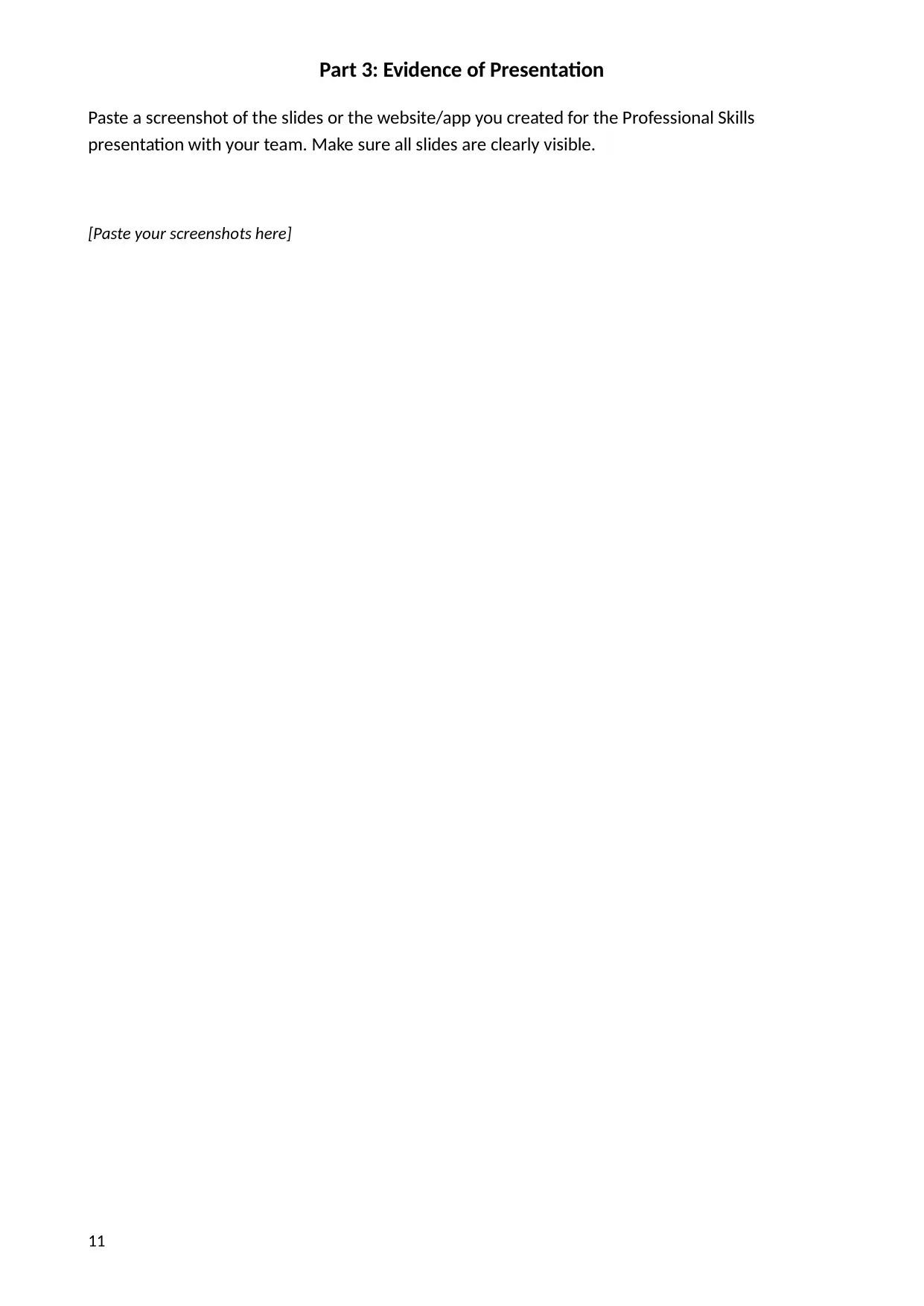
Part 3: Evidence of Presentation
Paste a screenshot of the slides or the website/app you created for the Professional Skills
presentation with your team. Make sure all slides are clearly visible.
[Paste your screenshots here]
11
Paste a screenshot of the slides or the website/app you created for the Professional Skills
presentation with your team. Make sure all slides are clearly visible.
[Paste your screenshots here]
11
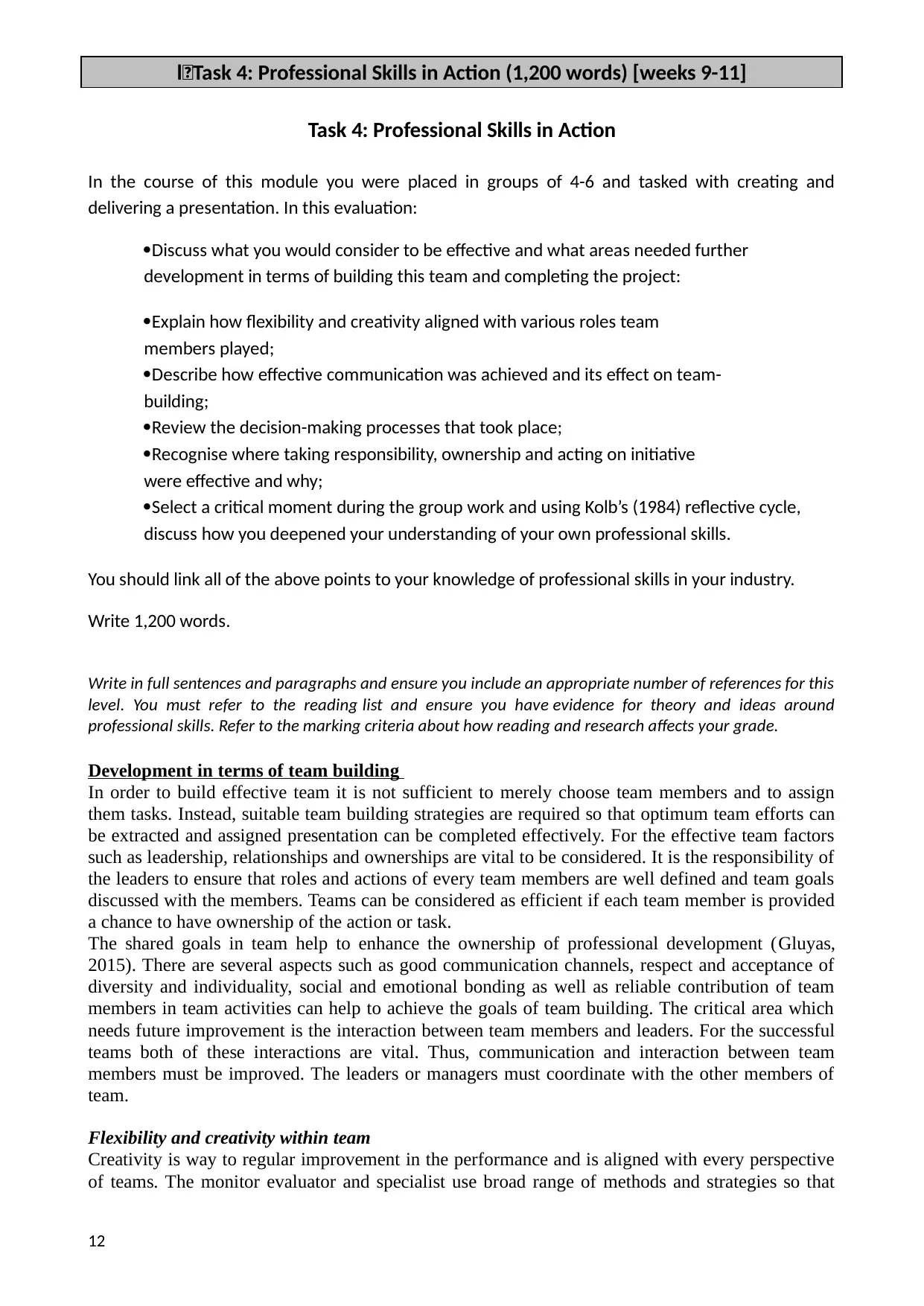
l壱Task 4: Professional Skills in Action (1,200 words) [weeks 9-11]
Task 4: Professional Skills in Action
In the course of this module you were placed in groups of 4-6 and tasked with creating and
delivering a presentation. In this evaluation:
·Discuss what you would consider to be effective and what areas needed further
development in terms of building this team and completing the project:
·Explain how flexibility and creativity aligned with various roles team
members played;
·Describe how effective communication was achieved and its effect on team-
building;
·Review the decision-making processes that took place;
·Recognise where taking responsibility, ownership and acting on initiative
were effective and why;
·Select a critical moment during the group work and using Kolb’s (1984) reflective cycle,
discuss how you deepened your understanding of your own professional skills.
You should link all of the above points to your knowledge of professional skills in your industry.
Write 1,200 words.
Write in full sentences and paragraphs and ensure you include an appropriate number of references for this
level. You must refer to the reading list and ensure you have evidence for theory and ideas around
professional skills. Refer to the marking criteria about how reading and research affects your grade.
Development in terms of team building
In order to build effective team it is not sufficient to merely choose team members and to assign
them tasks. Instead, suitable team building strategies are required so that optimum team efforts can
be extracted and assigned presentation can be completed effectively. For the effective team factors
such as leadership, relationships and ownerships are vital to be considered. It is the responsibility of
the leaders to ensure that roles and actions of every team members are well defined and team goals
discussed with the members. Teams can be considered as efficient if each team member is provided
a chance to have ownership of the action or task.
The shared goals in team help to enhance the ownership of professional development (Gluyas,
2015). There are several aspects such as good communication channels, respect and acceptance of
diversity and individuality, social and emotional bonding as well as reliable contribution of team
members in team activities can help to achieve the goals of team building. The critical area which
needs future improvement is the interaction between team members and leaders. For the successful
teams both of these interactions are vital. Thus, communication and interaction between team
members must be improved. The leaders or managers must coordinate with the other members of
team.
Flexibility and creativity within team
Creativity is way to regular improvement in the performance and is aligned with every perspective
of teams. The monitor evaluator and specialist use broad range of methods and strategies so that
12
Task 4: Professional Skills in Action
In the course of this module you were placed in groups of 4-6 and tasked with creating and
delivering a presentation. In this evaluation:
·Discuss what you would consider to be effective and what areas needed further
development in terms of building this team and completing the project:
·Explain how flexibility and creativity aligned with various roles team
members played;
·Describe how effective communication was achieved and its effect on team-
building;
·Review the decision-making processes that took place;
·Recognise where taking responsibility, ownership and acting on initiative
were effective and why;
·Select a critical moment during the group work and using Kolb’s (1984) reflective cycle,
discuss how you deepened your understanding of your own professional skills.
You should link all of the above points to your knowledge of professional skills in your industry.
Write 1,200 words.
Write in full sentences and paragraphs and ensure you include an appropriate number of references for this
level. You must refer to the reading list and ensure you have evidence for theory and ideas around
professional skills. Refer to the marking criteria about how reading and research affects your grade.
Development in terms of team building
In order to build effective team it is not sufficient to merely choose team members and to assign
them tasks. Instead, suitable team building strategies are required so that optimum team efforts can
be extracted and assigned presentation can be completed effectively. For the effective team factors
such as leadership, relationships and ownerships are vital to be considered. It is the responsibility of
the leaders to ensure that roles and actions of every team members are well defined and team goals
discussed with the members. Teams can be considered as efficient if each team member is provided
a chance to have ownership of the action or task.
The shared goals in team help to enhance the ownership of professional development (Gluyas,
2015). There are several aspects such as good communication channels, respect and acceptance of
diversity and individuality, social and emotional bonding as well as reliable contribution of team
members in team activities can help to achieve the goals of team building. The critical area which
needs future improvement is the interaction between team members and leaders. For the successful
teams both of these interactions are vital. Thus, communication and interaction between team
members must be improved. The leaders or managers must coordinate with the other members of
team.
Flexibility and creativity within team
Creativity is way to regular improvement in the performance and is aligned with every perspective
of teams. The monitor evaluator and specialist use broad range of methods and strategies so that
12
⊘ This is a preview!⊘
Do you want full access?
Subscribe today to unlock all pages.

Trusted by 1+ million students worldwide
1 out of 15
Related Documents
Your All-in-One AI-Powered Toolkit for Academic Success.
+13062052269
info@desklib.com
Available 24*7 on WhatsApp / Email
![[object Object]](/_next/static/media/star-bottom.7253800d.svg)
Unlock your academic potential
Copyright © 2020–2025 A2Z Services. All Rights Reserved. Developed and managed by ZUCOL.





